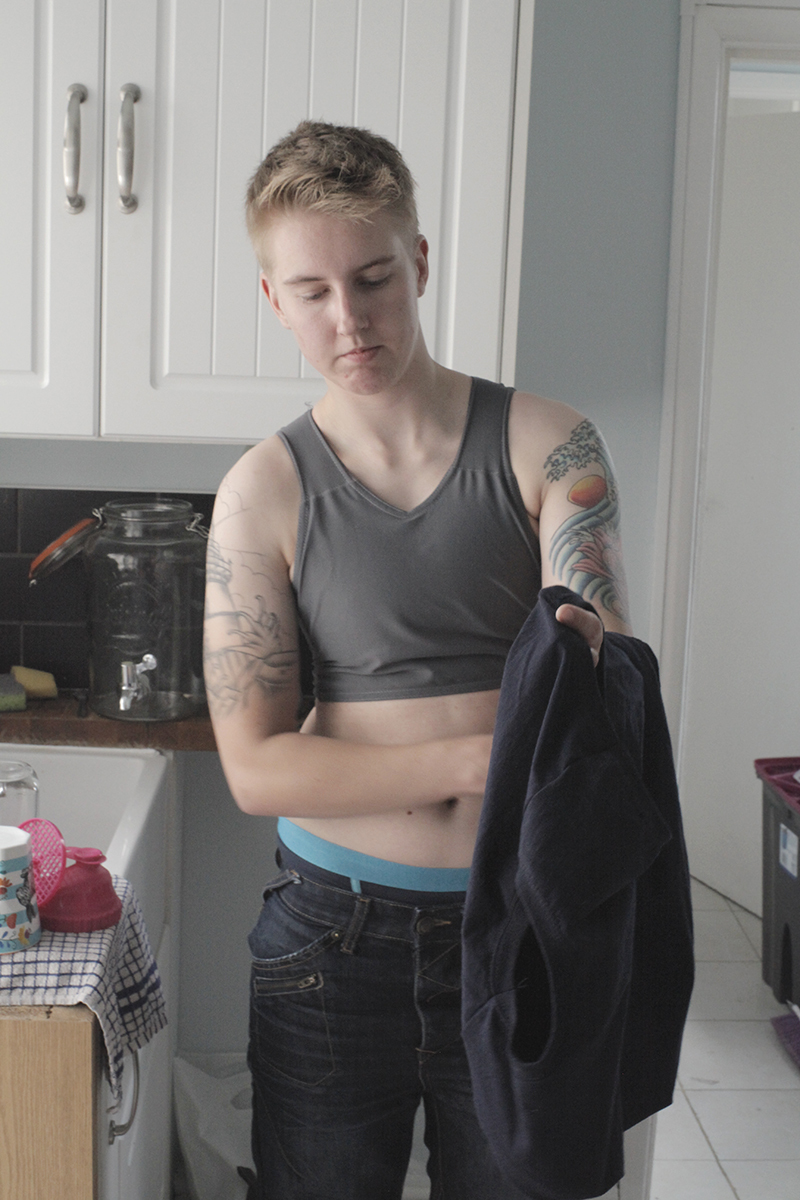User blogs
Gender is a societal construct. It enables people to assign a particular set of characteristics and attributes to a person based on their biological makeup. Many people think gender is biological. But it is simply not. There are people who are born as female biologically but they identify with the male gender. They begin to experience gender dysphoria at some point in time.
Those who experience gender dysphoria get abrupt mood swings; they get anxious for no visible reason at all. Life becomes very difficult for them as they are unable to fathom the source of their unhappiness. They are often diagnosed with mental illnesses and put on medication.
It is only when they realize that the source of all their agony is their biological gender which is different from the gender, they mentally identify with that they start considering some action to live the life they have always wanted to live.
Not all of them take the path of surgery to transition from female to male. Some try to change their look and appearance by dressing and overall behaviour. Irrespective of their biological makeup, they come out as a man in front of society.
But many choose to medically transition from a female to a male. A medical transition increases their chances of passing off as a male in society by multiple times. It also makes them somewhat less vulnerable to societal discrimination and abuse as they develop the outward manifestations of the gender they mentally identify with.
Gender Reassignment Surgery enables this transformation from female to male. There are many components of this surgery. There is the Mastectomy or top surgery that is typically the first surgical procedure performed on somebody who wants to transition from female to male. Many people opt just for Mastectomy and escape other procedures altogether.
Mastectomy helps in getting rid of the unwanted breast tissue and gives your chest that flat, manly appearance. There are a number of techniques involved in this procedure. Depending on your body structure and the results that you are looking at, a combination of these techniques may be utilized.
Then, there is the bottom surgery known as RFF Phalloplasty. In this surgery, the skin and veins from the forearm are used to construct a male phallus. There is another technique known as ALT Phalloplasty that can also be used to create a male penis. This technique utilizes skin and vein from the thighs instead to construct a male phallus.
Then there are other procedures also which a person transitioning from female to male might choose to undertake. There is Facial Masculinization Surgery and there is Body Masculinization Surgery.
Facial Masculinization Surgery has a set of procedures that can be used to give a more manly and chiseled appearance to the face. Body Masculinization Surgery is ideal for those who want to transform their body type to a more masculine type. It is a kind of liposuction technique that reduces a feminine hourglass figure and creates a masculine physique. This procedure can get you quite close to the ideal male figure that includes broad shoulders, trim waist and very less body fat in the lower body.
The medical procedure is just a part of transitioning. Transitioning from female to male is a complex process that has a social and psychological angle to it. You have to totally transform your identity in front of society. And for that, you have to mentally very strong, confident and be proud of your new identity.
There are a couple of tips you can follow in order to make your journey from female to male easier and less hassle-free.
Be Proud of Your Identity
You have to accept yourself before other start accepting you as a man. Societal discrimination and apathy are a part and parcel of transitioning. Do not let that intimidate you. You have to tell yourself that it’s perfectly normal to identity with a gender that is different from the one assigned to you at birth time.
Once you are comfortable with your identity, it’s important to go even a step ahead and celebrate it. Remember that you are unique and different. And it’s the habit of society to criticize everything that is unique and out of the box. But once they realize how valuable that thing is, they get crazy about it. That’s the way society works. So, once you start becoming proud of your identity and begin to revel in it, societal apathy will mean nothing to you.
People who are trying to make you conscious will shut up because you are not getting conscious! Accepting yourself is the first step in your journey of transition from female to male.
Begin Your Transformation by Coming Out
 People in your immediate circle need some time to get used to the male you. Your new life as a male might be unexpected for your friends and family, even if they support your decision. So, start by coming out as soon as you can. Take folks who are close to you into confidence. Tell them clearly about your newfound identity and the life you are going to live from now on.
People in your immediate circle need some time to get used to the male you. Your new life as a male might be unexpected for your friends and family, even if they support your decision. So, start by coming out as soon as you can. Take folks who are close to you into confidence. Tell them clearly about your newfound identity and the life you are going to live from now on.
This might be difficult because you might have a family that has issues with your identity. You are probably scared that they will not accept this. Well, you have to learn to be a bit tough here. It’s your life and your choice. You can try and convince your family for sure but you have to be willing to go solo. For someone who has a woman’s body biologically, declaring that from now on, they are going to live and behave like a man in front of their family is not going to immediately get them the understanding they deserve.
Your family might be even hostile to you when you come out in the open. So be prepared for anything. It is very important to have a set of people who genuinely support you and your identity. These people will become a bridge between you and society. They can be your friends, relatives, family members, anyone.
But it’s important to come out in the open with your identity because even after your transformation, your friends and family will take time to get used to the new you. Social acceptance will be a slow process. You have to just keep going on. Do not be disheartened by temporary troubles or roadblocks. As long as you are consistently embracing your new life as a male, it’s all good.
Start Dressing and Behaving Like a Guy
 This is a very important component of your transitioning. Even if you are mentally prepared to undergo a transition and have come out in the open, it can be very difficult to discard those old mannerisms you have been so used to.
This is a very important component of your transitioning. Even if you are mentally prepared to undergo a transition and have come out in the open, it can be very difficult to discard those old mannerisms you have been so used to.
You feel like a guy. You know it in your heart that you are a man. But if you continue to dress in women’s clothes, people around you would obviously not accept your masculinity. So, it is important to change your outward appearance too.
Begin to dress in men’s clothes. Start observing the behaviour of guys around you. Pay attention to their facial expressions, body language, the way they walk. These little cues will help you learn how to project a masculine image.
The internet too can give you a lot of information on how to incorporate masculinity in your day-to-day behaviour. For buying men’s clothing, check out what other guys on the street are wearing. And then pick clothes that would suit your appearance and build and would highlight your masculinity.
You might feel a bit awkward at first but if you keep at it, you will soon get used to it. And there will come a time when behaving like a man will come naturally to you. It won’t seem like you are acting or trying too hard. You already felt like a man in your heart. But with time, you will automatically start behaving like one externally as well.
Look for Professional Help
Your physical transformation is a very important part of transitioning. Of course, whether you want to undergo a medical transformation or not is totally your call. But if you are constantly anxious about not looking like a man enough physically, then surgery can help you get rid of that confusion.
You should first consult a therapist who would help you figure out the emotional and psychological problems you might be going through. The idea of transitioning from female to male can throw anyone’s mind into chaos and confusion. It’s a difficult state to be in. Your body is craving for an identity that is different from the biological identity assigned to you at birth. All this can get very complicated for your mind. So, a therapist will help you with the emotional and mental aspect of your transitioning.
Then you should look for a reputed and professional doctor who can offer you the best advice on the probable route you should follow for physical transformation from a female to male.
Facial hair is considered an attractive part of masculinity. The stereotype of the super ripped and rugged hyper-masculine guy with that formidable beard is like the main stuff of masculine folklore. But times are changing and the metrosexual guy with just a bit of stubble or even no facial hair is making his presence felt. Many trans guys still seem to be stuck in the age-old complex though that it’s mandatory to sport facial hair in order to look like a guy.
Nothing can be farther from the truth. How many cis guys you have seen who have facial hair? Not all of them obviously. There is a certain percentage of cis guys who have prominent facial hair while others might have little or none. While growing facial hair will certainly complement your appearance, it shouldn’t be like a do or die situation.
Because of the enormous pressure that trans men face in order to grow facial hair, a number of myths have sprung up regarding this. When you are desperate for something, you become vulnerable and then you are prone to trying out anything that promises you the thing you are after.
This article sets out to debunk certain myths about how to grow facial hair in transgender men. Let’s take a look at these myths one by one.
Myth – Certain Facial Products Can Help You Grow a Beard
Reality Check
There are many claims circulating around those facial products like Minoxidil can help a FTM transgender guy grow a beard. In fact, these claims propagate those particular facial products can actually play an important role in the growth of facial hair. The reality is there is absolutely no scientific basis to these claims. There is no evidence to support these claims. As a matter of fact, facial hair growth is largely determined by genetics. Look into your family history and see if your father or uncles sport a beard. It is largely your genes that determine the extent of your facial hair growth.
As a FTM trans guy, it’s very easy to fall into the trap of such a myth because you are obsessed with the idea of growing a beard. It’s obvious that you are willing to try out anything that promises you one.
But you need to use a little bit of rationality and common sense and realize that a beard will not grow overnight by some magic wand of a product. Just trust your doctor. If you are undergoing hormone replacement therapy and your genes support the growth of facial hair, you will definitely see results soon. Just have patience. Growing a beard takes time.
You have to be prepared for the scenario that you might not develop any facial hair at all. Don’t let this impact your self-esteem. There are so many other markers of manliness. As a result of medical transitioning and hormone therapy, your face is looking more masculine, you are developing muscles and you are confidently embracing men’s clothing. Celebrate all these wonderful things about your masculine identity rather than fretting about something that’s not in your control.
Myth – Taking Testosterone Promotes Facial Hair Growth
Reality Check
Reality check – Now, this is a very dangerous myth. It can actually have hazardous consequences on your health. The male hormone testosterone should be only taken in quantities prescribed by the doctor. If you overdose yourself with this hormone, it might have serious complications for your health. Testosterone by itself does not promote hair growth. Do not fall into the trap of making this simplistic cause and effect analysis that since it’s the most important male hormone, taking more of it would help you develop typical make characteristics like facial hair. If that were the case, all cis guys naturally having a high level of testosterone would be walking around with long beards!
The testosterone dosage that you are given during the Hormone Replacement Therapy, that itself will sufficiently aid the development of facial hair if your genetics support it. If you are unable to grow a beard, that’s alright too. Don’t risk your health and well-being for something that’s clearly beyond your control.
More importantly, don’t let superficial characteristics of masculinity determine your self-worth. Your identity is a lot more than a beard or facial hair. It’s more important that you feel like a man. Start dating someone through a trans dating site. Being with a woman who admires you and finds you attractive would make you feel way manlier than any amount of facial hair could ever do.
If you are still unhappy about not being able to grow a beard, check out trans male icons on the internet. You could check out their profiles on social media sites like Instagram. By taking a look at their personalities and style statement, your own sense of self-worth as a FTM transgender guy will increase manifold. And you will also notice that not all of them sport beards and yet, they are some of the hottest and most sought-after men around!
Myth – Shaving Promotes Beard Growth
Reality Check
This is yet another myth doing the rounds. Many FTM trans guys seem to think that shaving more and more would make their facial hair grow faster and thicker. Nothing can be farther from the truth. There is absolutely no scientific evidence to support the claim that shaving promotes beard growth. On the contrary, it will just ruin whatever little growth you have. So, if you are growing a beard at a super slow pace, just be patient and you will see some results sooner or later. Do not rush into shaving.
 This point cannot be reiterated more that do not make facial hair growth an ego issue. It is not the ultimate sign of your masculinity. Embrace other manifestations of your masculinity like dressing, grooming, dating, relationships, etc. Check out specific avenues for trans men dating. Do not let something as arbitrary as the absence or presence of facial hair define your masculinity.
This point cannot be reiterated more that do not make facial hair growth an ego issue. It is not the ultimate sign of your masculinity. Embrace other manifestations of your masculinity like dressing, grooming, dating, relationships, etc. Check out specific avenues for trans men dating. Do not let something as arbitrary as the absence or presence of facial hair define your masculinity.
If you are unable to grow a beard and are totally freaked out and traumatized, consider joining a transgender forum. Talk to other FTM transgender guys out there. Mutual sharing of experiences would help you understand that it’s not a big deal to be not able to grow facial hair.
If nothing works out and not being able to grow facial hair is making you feel depressed and miserable, you could consider getting a facial hair transplant. Many medical establishments offer this surgery and it is getting increasingly popular. Although, it is strongly advised that a FTM transgender guy waits for at least a year after the initiation of hormone therapy if they are considering a facial hair implant. This would enable the surgeons to give you a more targeted treatment and concentrate on regions in your face that are in maximum need of facial hair.
Although before taking any decision, you must do ample research from your end regarding the details of this surgery or if there are any possible complications or side effects. Only after you’ve undertaken a comprehensive and impartial assessment from your side, should you reach a final decision. Take your doctor into confidence as well; the one who is giving you hormone therapy. To be honest, they are the best person to advise on this matter that you need a facial hair transplant or not.
Beard Transplantation is also a popular technique within plastic surgery. Many cis men who are unable to grow a beard because of their genetic characteristics but desire one also opt for this procedure. Although the disclaimer for all these procedures is that you need to ideally have sufficient healthy hair on your scalp because that’s from where the hair is taken.
If you are a FTM transgender guy wanting to grow a beard and your genes do not favour it, you could consider these cosmetic surgery procedures. But you have to be very careful and make sure that such a treatment does not interfere with any other procedures you are undergoing, as part of medical transitioning. Give it some time. Do not take a decision in a jiffy.
Try and focus on other aspects of your masculinity. Exercise, eat well, maintain good personal hygiene and just generally be well-groomed. This routine, along with the hormone replacement therapy should work well for your masculine appearance. Some people even choose to undergo facial masculinization surgery in order to make their faces more masculine and chiselled. If you still think that beard is an inseparable part of your masculine identity, consider a facial hair transplant. But weigh the pros and cons well before deciding to undergo the procedure. Also, make sure you are getting it done from a reputed place where the surgeon has expertise in this particular surgery. Always check out the reviews of a medical establishment before you choose it for treatment. Try finding out if there is anyone from your own circle of friends and acquaintances who have opted for a beard surgery. Ask for their feedback and review.
As a FTM transgender man, you make so many efforts to look masculine and incorporate male behavioural patterns in your body language and communication. You pay extra attention to your wardrobe and the way you carry your clothes. Most FTM trans guys also take the Hormone Replacement Therapy in order to develop the physical attributes of manliness. But there is one area which might not seem like a dead giveaway but nevertheless, it is something that makes you conscious as a trans man. This is the crotch area. Since as a FTM trans guy, you do not possess the private parts of the male gender, this can impact your self-image and make you question your masculinity.
In order to overcome this discomfort, many trans guys resort to packing. Simply put, packing is the process of artificially creating a male-like bulge in the crotch area. It is a technique that simulates the crotch area of a man using various devices and aids. Packing is especially beneficial for those FTM transgender guys who haven’t undergone gender reassignment surgery.
Packers are available in different varieties, sizes, and price ranges. From the simplest of packers that literally just help create that bulge in your crotch area to more advanced ones that simulate the male reproductive organs with absolute dexterity, there is a wide variety of those available.
Although one has to understand than not all FTM trans men feel the need to pack. Some don’t feel the need for it at all, as the supposed absence of manliness in their nether regions doesn’t bother them. It does not affect their identity. But there are others to whom this can be a source of acute discomfort and anxiety. It is a part of gender dysphoria, also known as bottom dysphoria.
Many Transgender guys also choose to pack because it increases their chances of passing off as a man in public places and saves them from potential harassment. You might think that nobody really stares hard at your crotch area in a public place but if you are wearing tight trousers or fitted exercise lowers, the absence of a bulge can be obvious. Some people might choose to ignore even if they notice. But if someone creates an issue out of it, it can be embarrassing and also become a safety concern. Society is very prejudiced against transgender people. And it looks for opportunities to bully and trouble them. For many trans men, packing saves them from that potential harassment and sometimes even violence and abuse.
There is such a mind-boggling variety of packers available in the market that it is difficult to figure out which one to buy and where to start. This article gives you a couple of tips on how to pack as a transgender man.
Start Packing with a Sock
 This is useful for trans men who want to pack but are not quite sure if it’s the right thing for them. Before buying a packer, you can actually start packing using a sock. This is a fairly common method in the trans community. It is inexpensive, easy to implement and you don’t have to worry about any side effects or skin infection.
This is useful for trans men who want to pack but are not quite sure if it’s the right thing for them. Before buying a packer, you can actually start packing using a sock. This is a fairly common method in the trans community. It is inexpensive, easy to implement and you don’t have to worry about any side effects or skin infection.
Packing with a sock simply involves folding the sock in a certain way and placing it strategically inside your underwear so that a male-like bulge can be created. There are many tutorials available on how to pack with a sock online. You can do some research and check out with a transgender blog that talks about packing with socks.
Although this won’t give you a realistic-looking bulge in terms of resemblance but it’s a great way to start. Moreover, nobody really notices these things that carefully. If you check out the nether regions of a cis guy who is wearing jeans or trousers, you can just make out that there is a little bit of bulge. You do not really see the outline of the male reproductive organs as such.
Once you start packing with a sock, you will soon find out if packing is for you at all. And then once you are comfortable, you can ready yourself for buying a commercial packer.
Figure out Your Needs and Budget before Buying a Packer
There are so many different kinds of packers available in the market. It is important to figure out your specific needs and preferences before investing in one. Budget too is an important factor. Silicone packers are considered the best if you want a hyper-realistic packer that simulates the male genitalia with perfection. Silicone packers are considered the safest for prolonged skin contact. But again, the flip side is that these are generally quite expensive.
Then, there are foam packers which might be great for FTM transgender men who just want a manly-looking bulge without the look of a penis. The foam packer is pretty lightweight. It is also a good option for those who might be allergic to silicone.
As a FTM transgender guy, you also need to figure out the exact purpose of buying a packer. Do you just need it in the public or is it something you need for sexual pleasure as well? The kind of packing that you generally do for outdoors like when you are in a gym or a public place is known as soft packing. However, if you need packing specifically from the point of view of physical pleasure during lovemaking, hard packing will be your thing. Hard packing would incorporate something like a dildo or another prosthetic device that would be upright and erect.
While a hard packer is great for your love life, it would be awkward to wear one for daily use. You would just attract unwanted stares and attention in a public place if you sport one. So the best is to just use a soft packer on a daily basis and keep the hard one reserved for your lovemaking sessions. Also, hard packing can cause irritation in your private parts, so keep all that into account before buying one.
Then, there are STP Packers which can be especially useful for a FTM transgender guy as these will help you urinate while standing like a man. However, you need some practice before using this kind of packer. It can be awkward at first but you will soon get used to it.
You can interact with other trans men through a transgender forum and figure out which packer works best for them. Packing is an important part of your masculine identity and you shouldn’t be shy or embarrassed to ask questions on this topic.
Buy a Packer that’s Just the Right Size
As a FTM transgender guy, you might be tempted to buy a large-sized packer, thinking it will be an asset to your masculinity. But the reality is that would just look odd and would draw unwanted attention. Always buy a packer that’s just the right size keeping in mind your body proportions, not too big and not too small.
Well, if you do want to go for an oversized packer, that’s totally your choice. But it’s certainly not going to help you with the goal of passing off as a regular guy. Just try and judge the right size going by your own body proportions. If you are a tall and huge guy, then a large packer would actually complement your physicality.
You Could Also Consider Packer Specific Clothing
Packer-specific clothing is getting popular these days. As a FTM transgender guy, you could buy different kinds of underwear that are specially designed for packing. There are specific boxer briefs with pouches to slip in the packer. Such clothing can be useful to a trans man, especially while he is learning how to pack. This can save him the constant stress and worry that what if his packer slips off.
It Will Take a While to Get Used to Packing
 Many FTM transgender men do not go for packing simply because it makes them feel uncomfortable in their private parts. You have to keep in mind that it will take you a while to get used to packing. The initial phase will be challenging. You might feel awkward walking. You might be conscious of the packer all the time and feel super stressed out in a public place thinking that everybody is just looking at you.
Many FTM transgender men do not go for packing simply because it makes them feel uncomfortable in their private parts. You have to keep in mind that it will take you a while to get used to packing. The initial phase will be challenging. You might feel awkward walking. You might be conscious of the packer all the time and feel super stressed out in a public place thinking that everybody is just looking at you.
But there is no need to worry. After a while, you will get adjusted to packing and it will become a part of your identity. Just make sure you practice walking around with a packer on as much as you can. Not just walking but general activities like household chores, exercise, dancing, etc should also be practiced with a packer on. You could easily practice in your house. The idea is to get used to packing as much as you can before you begin to use it in a public place.
As a FTM transgender guy, remember that packing is not just about others noticing that there is a bulge in your crotch area. It’s about your own affirmation in your masculinity. Packing is supposed to help you with dysphoria and make you feel super comfortable and confident with your masculine identity. So invest time and energy in learning how to pack. Make it a part of your life.
It is completely normal for Trans Men do not want to get gender reassignment surgery for numerous reasons. This doesn’t mean you will have to look like a female for the rest of your life. Here are a few ways to make yourself look less feminine without having gender reassignment surgery:
Cutting Your Hair
Long hair is one trait generally associated with women and girls. So, if you want to look less feminine you should consider getting a haircut. The right haircut will highlight your face’s bone structure and make you look manlier. For the best haircuts, consult a barber or a hairdresser. These persons are trained in cutting hair and getting a botched haircut from yourself or a friend will make you look untidy or poorly groomed.
Binding Your Chest
Breasts are another trait associated with women and girls. If you want to look less feminine, they will have to go. But remember this is about looking less feminine without getting gender reassignment surgery. One way to reduce the appearance of your breasts is by binding them. There are many methods and tips available online for binding your chest but be careful not to choose any that may be harmful or may cause discomfort.
Getting a New Wardrobe
The right wardrobe can without a doubt make you look less feminine. Please note that this does not mean baggy pants, beanies, and oversized shirts. This simply means choosing the right kinds of clothes. Certain patterns on shirts can accentuate the bulge your breasts make, such as stripes, and should be avoided. Pleated pants and skinny jeans hug your curves and make you look feminine. Avoid those and opt for straight cut pants that will hide your bum and your curves. Trade in those flats and heels for sneakers, boots and male shoes. Accessories such as belts and watches can also make you look more masculine.
Packing
To be taken seriously as a man, you must have a bulge. This is the outline of your penis in jeans or shorts. Because you are not getting the surgery, you will have to improvise. Luckily, there are many underpants that come with built-in bulges and are designed specifically for FTM Transgender Men. You don't have to pack every day, but it certainly makes you look much more believable. You will have to decide if you want to hard pack or soft pack but this all depends on your environment. If you have a hard pack everywhere you will look like a pervert. So please bear in mind your surroundings and the people that will be around you.
Adapting Masculine Mannerisms
The way you walk, talk, dress, sit, stand or even eat can make or break your efforts to look less feminine. Men usually maintain good posture and sit with their legs open. They also walk tall, without swinging hips, with their shoulders back and heads held high. Certain phrases and terms of endearment are rarely used by men and should be avoided. Try to observe the men in your surroundings and mimic their movements and soon you’ll catch on to what society deems as “masculine behavior”. Making yourself look less feminine without getting “the surgery” is not entirely difficult and if done properly, no one will be able to tell the difference!

